13 February 2023
Singing the unspeakable, with Sanne Kabalt – by Anika Mariam Ahmed
Syb Circles
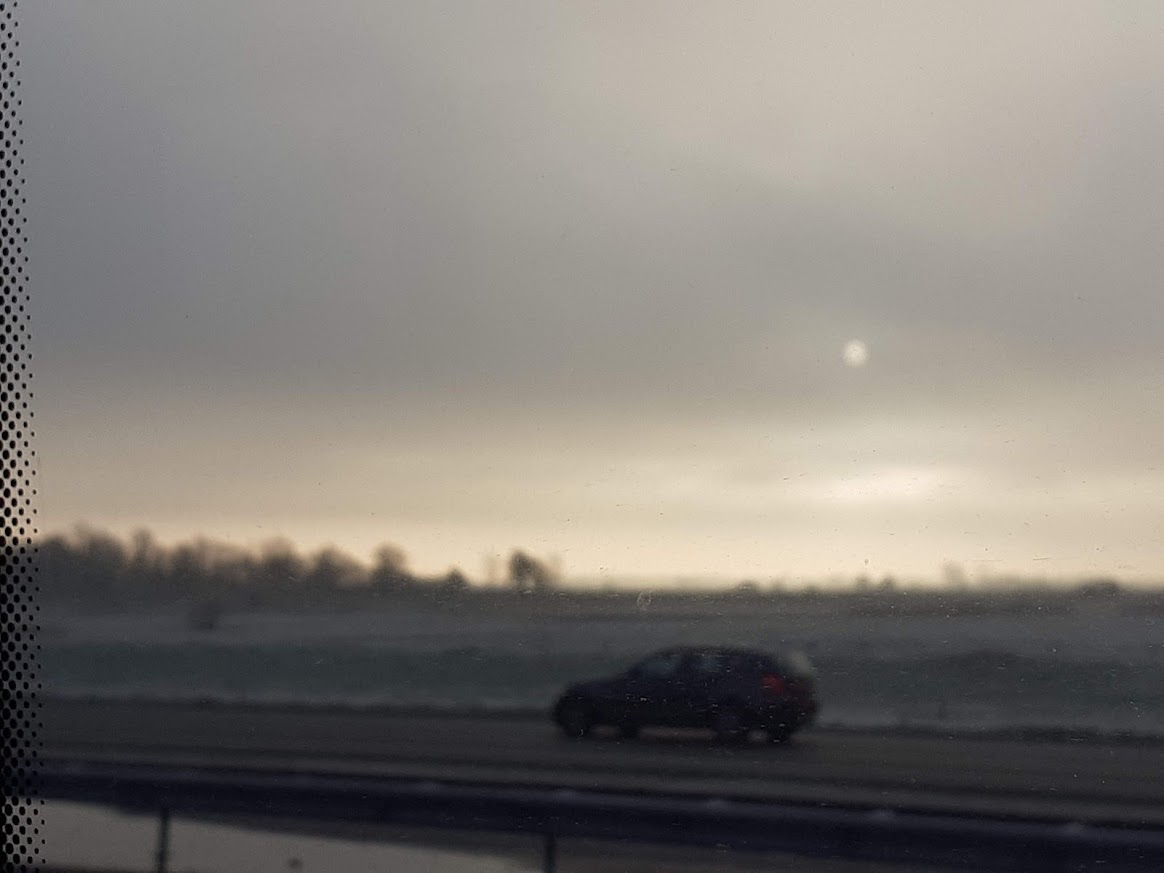 Foto: Anika Mariam Ahmed
Foto: Anika Mariam Ahmed
Anika Mariam Ahmed (b. 1988, Dhaka, Bangladesh) is a painter living in Groningen, the Netherlands.Her work captures the poetry in everyday life and celebrates the sensual, non-verbal qualities of paint. She teaches a course on difference and equality in the field of arts at the Frank Mohr Institute and is part of SYB since 2020.
Anika wrote a reflection on the residency of Sanne Kabalt, who was in residence from November 18 to December 23.
During her residency at SYB, Sanne has been working on a new project about lullabies/widzesankjes/wiegenliedjes. What caught her artistic curiosity is that the songs used to lull children to sleep often seem to serve another purpose as well: to express the worries of the singer (usually the mother). The ‘recipient’ of the song does not yet speak a language and is soothed by a familiar voice, rocking rhythm and melancholy melody. Meanwhile, the ‘giver’ of the song can give voice to their own doubts and troubles in the lyrics.
__
SINGING THE UNSPEAKABLE with Sanne Kabalt
by Anika Mariam Ahmed
I think it was one of the first nights this winter that it froze. I was on the bus from Groningen to Beetsterzwaag and saw through the early morning haze – the mellowed sun beaming like the moon – frosted fields. It felt a bit warmer on entering Kunsthuis SYB, where a coffee table laid out with cookies welcomed conversation.
I had meant to visit current resident Sanne Kabalt a week prior. We planned multiple dates which had to be cancelled because either of us, and our babies- had a cold, or we did not have a babysitter or daycare for the day. We are both new mothers, Sanne newer, and I was already glad for the flexibility and understanding with which we communicated and from my part at least, I was glad not to feel less capable at work for being more of a mother.
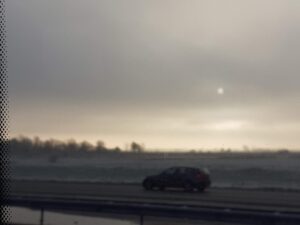
Foto: Anika Mariam Ahmed
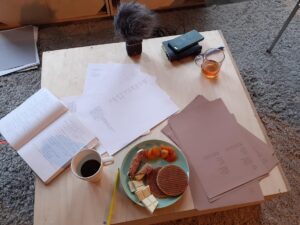
Foto: Anika Mariam Ahmed
In many other contexts, I might have brushed this bit under the rug. Sanne however, makes room for exactly this kind of conversation. She was doing this residency with her five-month-old baby and exploring lullabies, the playing field of parents and caregivers. Before I arrived, we had settled it between us that our time together might be dotted with moments of breastfeeding and pumping, and during one such break I got a chance to see a projection set up by Sanne in a space at the back of the building.
The projection seemed to barely emerge from the walls in this kind of work-in-progress setting that houses SYB. It was a recognizable image, the silhouette of mother and child, moving, bobbing, across the length of the projection. At moments this silhouette became one albeit distorted figure, two beings morphed together. Or that of a woman with the child in the womb. Maybe I am projecting but I remember thinking in those first months after my child was out in the physical world: where do I end and where does he begin?
This symbiotic relationship shows itself in lullabies. “I read a text [Music for Dreaming by Elisabeth Mackinlay] where they speak of the giver of the song and the recipient of the song,” says Sanne. “In lullabies this is clearer than in most other music. Usually there are many people listening to a song and you don’t even know who is listening, whereas this is so intimate. It takes place between two people, and with a very clear purpose: to give rest.” The intimacy of this bond between mother and child, and the feelings that the mother expresses in these songs, are protected by this soft, becoming nature of the video projection.
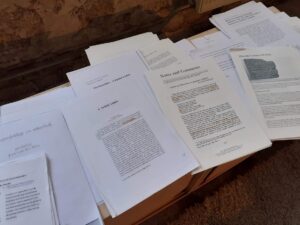
Foto: Anika Mariam Ahmed
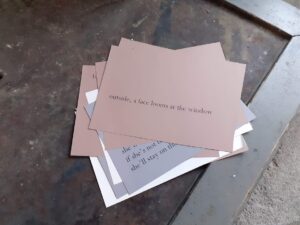
Foto: Anika Mariam Ahmed
Sanne is drawn to the less sweet aspects of lullabies that deviate from our general associations with these tender renditions. She finds out instances from these songs sang across regions, possibly for generations, which speak of troubles experienced by the one singing. Mothers singing about the absent father. Nannies singing of being fed up with a crying baby whom she cares for in exchange of rice. Mothers singing of fatigue and the need for her to sleep, too. “I am mainly focusing on the – to me, surprising parts; the dark, realistic parts in the lyrics. Alongside soothing subjects, I found infinite references to pain, depression or weariness. Imagine a mother singing a line like ‘my baby is my undoing’ to her baby, or ‘it’s not worth waking up’. There’s a very scary lullaby where eagles swoop down on the baby and tear it to pieces, even – a nightmare scenario within a lullaby.” Sanne was extracting lines from different lullabies with the same theme and putting them together to form new songs, which become haunting by the repetition of sentiment. The absent father becomes starkly absent across time and place.
Prior to this residency, Sanne has worked with themes such as sickness and death. “The things that really move me are not always the lightest themes. You come across these things in life, you recognize them and you feel- this moves me, deeply. I need to do something with that, find a shape for it or a way to talk about it. For me art can be that way.”
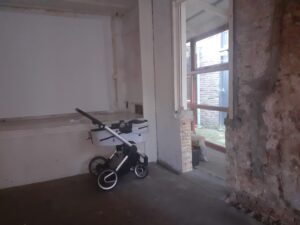
Foto: Anika Mariam Ahmed
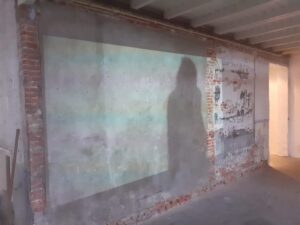
Foto: Anika Mariam Ahmed
With this work Sanne easily creates a space for difficult conversations around motherhood and for bringing up complex feelings that are left unsaid for reasons external and internal. And in that she joins this long line of caregivers who have done this through lullabies. “I love being a mother, but there is a side to it that is not only easy, not only sweet. It’s also troubling and disturbing in many ways. It was while diving deeper into lullabies that I started to recognize these things from my own experience. It set me thinking: how amazing, simultaneously scary and powerful, that women (mainly) from all over dare to say these things and find a place for them. Because they are almost unspeakable but then they are allowed to be somewhere, in this secret, intimate realm where nobody really hears what you are saying. They find a moment to be voiced, and I think it is important that they are allowed to exist.”
I recognize a soft power in Sanne’s work that perhaps draws her too to these lullabies. At the risk of sounding New Age, it is quite healing, the room that Sanne creates. She creates it with melodies which she sings herself in different languages – Norwegian, Frisian, Russian and Brazilian Portuguese among others – and that soothes you, and the figures rocking back and forth lull you. And in its sweet nature, you feel that you are allowed to voice your innermost unspeakables and bring them to light. Because it’s okay, and because all kinds of unsayable thoughts are allowed to exist and have existed across time and place. You just create your room for it. I started the interview questioning Sanne’s interest in the dark aspects of our existence and went away feeling quite light.
